
The Araceae are a family of monocotyledonous flowering plants in which flowers are borne on a type of inflorescence called a spadix. The spadix is usually accompanied by, and sometimes partially enclosed in, a spathe. Also known as the arum family, members are often colloquially known as aroids. This family of 114 genera and about 3,750 known species is most diverse in the New World tropics, although also distributed in the Old World tropics and northern temperate regions.

Alocasia is a genus of rhizomatous or tuberous, broad-leaved, perennial, flowering plants from the family Araceae. There are about 90 accepted species native to tropical and subtropical Asia and eastern Australia. Around the world, many growers widely cultivate a range of hybrids and cultivars as ornamentals.
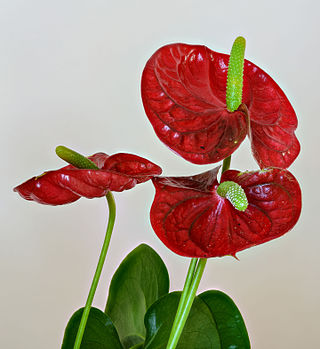
Anthurium is a genus of about 1,000 species of flowering plants, the largest genus of the arum family, Araceae. General common names include anthurium, tailflower, flamingo flower, pigtail plant, and laceleaf.

Alocasia macrorrhizos is a species of flowering plant in the arum family (Araceae) that it is native to rainforests of Maritime Southeast Asia, New Guinea, and Queensland and has long been cultivated in South Asia, the Philippines, many Pacific islands, and elsewhere in the tropics. Common names include giant taro, giant alocasia, ʻape, biga, and pia. In Australia it is known as the cunjevoi.
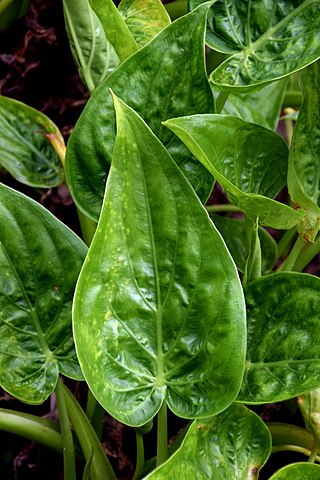
Alocasia cucullata is a species of flowering plant in the arum family known by the common names Chinese taro, Chinese ape, Buddha's hand, and hooded dwarf elephant ear. It is kept as an ornamental plant.

Thaumatophyllum xanadu is a perennial plant belonging to the arum family Araceae and the genus Thaumatophyllum, formerly classified under the Meconostigma subgenus of Philodendron. This plant is native to Brazil, but is widely cultivated as a landscape plant in tropical, subtropical and warm temperate climates.

Alocasia sinuata, commonly known as Alocasia quilted dreams or Alocasia 'Bullata', is a flowering plant in the family Araceae. It is endemic to the limestone forests of Samar, Leyte, and parts of Mindanao in the Philippines. It is classified as critically endangered by the International Union for Conservation of Nature. Despite its critically endangered status, it is grown commonly as a houseplant.
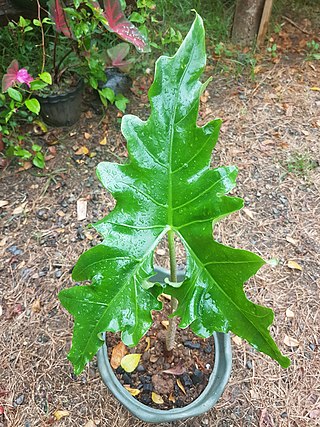
Alocasia nycteris, commonly known as the bat alocasia or the batwing alocasia, is a plant in the family Araceae. It is endemic to island of Panay in the Philippines. It is cultivated as an ornamental plant.
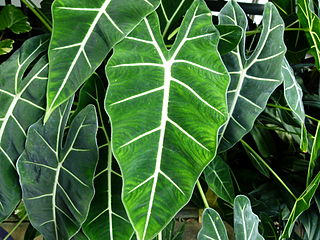
Alocasia micholitziana, commonly known as the green velvet taro or green velvet alocasia, is a plant in the family Araceae. It is endemic to the island of Luzon in the Philippines. It is commonly grown as an ornamental plant worldwide.
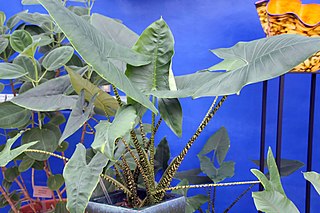
Alocasia zebrina, commonly known as the zebra plant or zebrina alocasia, is a plant in the family Araceae. It is endemic to the islands of Luzon, Mindanao, Leyte, Samar, Biliran, and Alabat in the Philippines. It is commonly grown as an ornamental plant worldwide. It is also locally known as gabing tigre in Tagalog. It is nationally listed as a threatened species and collection of A. zebrina from the wild is illegal in the Philippines.

Alocasia heterophylla is a plant in the family Araceae. It is endemic to the islands of Luzon, Mindanao, and Polillo in the Philippines.

Alocasia reginula, black velvet, is a species of flowering cormous aroid, native to Sabah state in Malaysia. This plant, often referred to as one of the "jewel" Alocasias, became increasingly popular among plant hobbyists between the years 2018 to 2020. Until as recently as 2021 though, not much was known about the plant or its origins. Originally described from cultivation, and often sold as “Alocasia 'Black Velvet'”, it is not a modern cultivar or hybrid; A. reginula is its own natural species. It is only known from dry, deeply shaded limestone cliffs in Tabin Wildlife Reserve. As a houseplant it needs sharp drainage or it will very likely rot.

Alocasia portei is a species of flowering plant in the family Araceae, native to Luzon in the Philippines. With Alocasia odora it is the pollen parent of the large landscaping plant Alocasia × portora.

Alocasia sarawakensis is a species of flowering plant in the elephant ear genus Alocasia, native to Borneo. Unusually for an aroid, it is a freshwater swamp forest obligate, preferring well-lit situations. A large species, it can reach 8 ft (2.4 m). A cultivar, 'Yucatan Princess', is commercially available.

Alocasia brancifolia is a species of flowering plant in the family Araceae, native to the Moluccas and New Guinea. With its heavily dissected leaves it is sometimes kept as a houseplant. There appears to be a cultivar, 'Pink Passion', in which the markings on the petioles are pink instead of the usual brown.
Alocasia princeps is a species of flowering plant in the family Araceae, native to Borneo. With its V-shaped leaves it is sometimes kept as a houseplant. There are two cultivars, 'Purple Cloak' and 'Candy Sticks'.

Alocasia lauterbachiana, the purple sword, silver sword, or baroque sword, is a species of flowering plant in the family Araceae, native to northern New Guinea and the Bismarck Archipelago. With its upward-pointing leaves reaching 1.5 m (5 ft), it is kept as a houseplant and is readily available in commerce.
Alocasia scalprum, the Samar lance, is a species of flowering plant in the family Araceae, native to Samar island, the Philippines. Well known from cultivation as a houseplant in the Philippines, and introduced to aroid enthusiasts as Alocasia cv. Samar Lance in 1984, it was not formally described as a species until 1999. Its glossy, lance-shaped leaves with embossed veins take on a blue sheen when mature. It is similar in appearance to Alocasia heterophylla.
Alocasia atropurpurea is a flowering plant in the family Araceae endemic to northern Luzon in the Philippines. It is classified as Critically Endangered by the IUCN Red List of Threatened Species and has only been recorded in Mount Polis and an unspecified locality in the Mountain Province.

Alocasia × mortfontanensis, the African mask plant or Amazonian elephant ear, is an artificial hybrid species of flowering plant in the family Araceae. Its parents are Alocasia longiloba and Alocasia sanderiana, the kris plant. A rhizomatous perennial reaching 1.5 m (5 ft), it has gained the Royal Horticultural Society's Award of Garden Merit as a house plant.


















